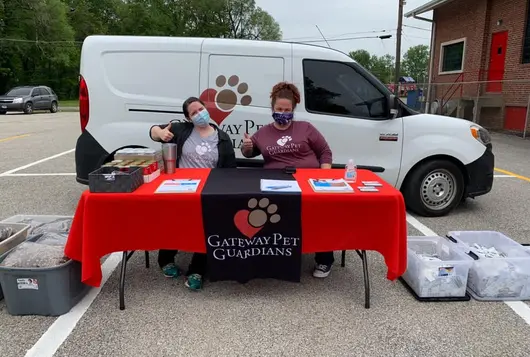A Spectrum of Care is the Antidote to One Dog’s Mysterious Illness

When Cindy, a 3-year-old mixed-breed dog, stopped eating and began vomiting, her owner, Elmerlinda, was alarmed. Elmerlinda and Cindy had just returned from a 3-month visit to Puerto Rico, where Elmerlinda had adopted Cindy when she was just 6 weeks old. “I thought maybe she picked up something on our trip,” says Elmerlinda.
Having visited the ASPCA Animal Hospital the previous year when she had to put her 14-year-old cat, Mimi, to sleep, Elmerlinda reached out to the ASPCA again.
Improving Access to Veterinary Care
Elmerlinda, who is retired and lives on Manhattan’s Lower East Side, had used veterinary services before—including an emergency vet when Cindy bled uncontrollably after being spayed—but the cost of that care put a strain on her personal finances. “It was all very expensive,” she says.
To help pet owners like Elmerlinda, the ASPCA works to make veterinary care more accessible and affordable. Affordable veterinary care does not indicate inferior veterinary care because the most technologically advanced and expensive options are not necessarily more effective than less expensive courses of action.
“There are many ways to treat an illness, not just one,” says Dr. Camille DeClementi, Vice President of the ASPCA Animal Hospital, which serves pets and also trains veterinarians. “We want to influence other veterinary professionals to provide less intense care, which provides the same outcome but is not as costly.”
Research supported by the ASPCA and other organizations suggests that pets have better outcomes when veterinarians provide a wide range of treatment options—otherwise known as a spectrum of care.
“A spectrum should range from basic, lower-cost options that offer a good outcome, to more advanced, higher-cost options that also offer a good outcome,” says Morgan Lucas, Certified Veterinary Technician and Team Leader of Veterinary Support. “The care options should have an achievable goal that is influenced by the owner’s goals and the resources available to both the owner and the veterinary team.”
“Shifting the perception that there is only one ‘best’ option changes the focus to providing an array of options based on clinical research, scientific evidence, and the needs of the individual animal and their family,” says Dr. DeClementi.
Dr. Anna Whitehead, Director of Medical Trainees at the ASPCA Animal Hospital, believes honesty and transparency are important to maintaining productive relationships with clients. “If a client asks what I would do if it were my pet, I answer truthfully and tell them why that decision is best for me,” says Dr. Whitehead. “But what’s best for me may not be what’s best for them.”
A Menu of Options
In Cindy’s case, Dr. Daniela Gilbert, Staff Veterinary Manager at AAH, first took steps to diagnose Cindy and then discussed a spectrum of treatment options with Elmerlinda. To rule out the possibility of a foreign body, Cindy was sedated for x-rays, which were clear. (Often, pets swallow items that become lodged in their intestines or stomach.) Cindy also had an in-house blood test performed to help determine how dehydrated she was and assess for changes that can occur with vomiting.
“Luckily, Cindy’s basic bloodwork and x-rays did not show any abnormalities, and she was bright and alert on her exam,” says Dr. Gilbert. “In many scenarios, a dog not eating for 3 days and vomiting might need to be hospitalized, no matter what the cause.”
"Hospitalization on IV fluids could have also been an option, but this would significantly increase the cost to Cindy's owner, and Cindy was stable," explains Dr. Gilbert. "If Cindy didn’t improve with medical management at home, the next step would be to return for an ultrasound and potentially hospitalization."
Cindy was treated with a few injections to help with nausea and dehydration, and Elmerlinda agreed to monitor Cindy at home. Cindy was also sent home with a dewormer medication and an appetite stimulant. Days later, Cindy was “eating normally, happy, and barking again,” according to Elmerlinda.
“I think the big cost saver was determining not to hospitalize Cindy and treat her at home with supportive care,” says Dr. Gilbert. “She seemed stable enough to treat as an outpatient, so we avoided the cost and resources of further testing and hospitalization.”
While it’s still a mystery what made Cindy so ill, it’s clear that the spectrum of care led to an outcome that keeps Cindy healthy and Elmerlinda happy.
Bringing Access to Veterinary Care Forward
Access to veterinary care (AVC) means owned dogs and cats universally and equitably receive care that improves their welfare, decreases suffering, and is compassionate, respectful, and considerate of pets and family circumstances. AVC is increasingly noted as a concern by pet owners and animal welfare professionals. A 2018 survey by the Access to Veterinary Care Coalition found that 28% of pet owners experienced a barrier to care in the last 2 years, and 23% were unable to provide preventive care for at least 1 of their pets. Combine that with Pets for Life data that approximately 17 million pets in underserved communities have never seen a veterinarian, and the magnitude of the issue becomes clear.
Want to do more to move the needle on AVC?
- Visit the AVC Resource Library.
- Register for the AVC Conference (Virtual, October 17-19, 2023).
- Review AVC Research.
There are many ways to treat an illness, not just one.
We have lots more on this subject:

